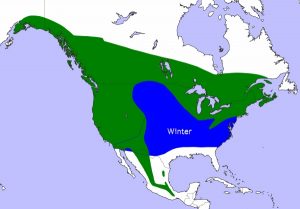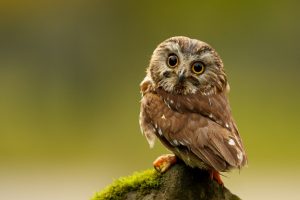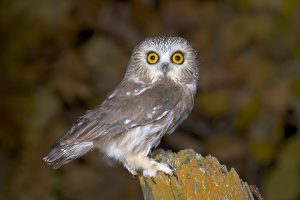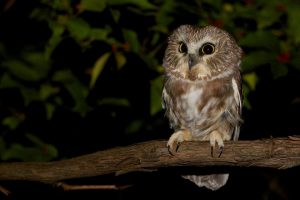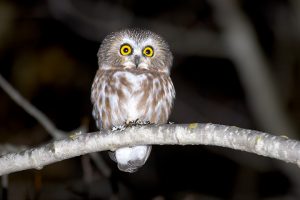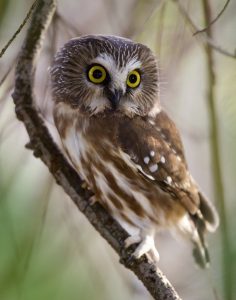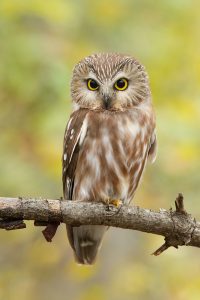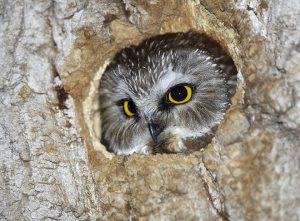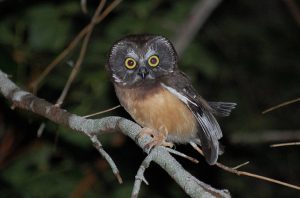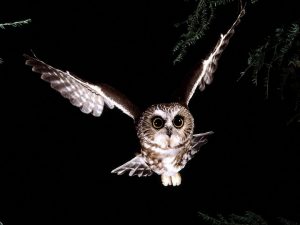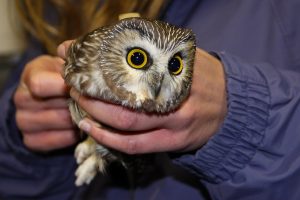Northern Saw-Whet Owl
Northern saw-whet owls are small birds found in North America. They are the smallest owl found in the east of the continent. They are successful hunters at night but spend the day being rather inconspicuous. Their broad range of distribution ensures its population’s security for some time to come.
Scientific Classification
| Kingdom | Animalia |
| Phylum | Chordata |
| Class | Aves |
| Order | Strigiformes |
| Family | Strigidae |
| Genus | Aegolius |
| Scientific Name | Aegolius acadicus |
Quick Information
| Also Known As | Kirkland’s owl, Queen Charlotte owl, saw-filer, Acadian own, whetsaw, sparrow owl, white-fronted owl, petite nyctale (French), tecolotito cabezon, lechucita cabezona (Spanish) |
| Similar to | Short-eared owl |
| Identification | Size: 6.7-8.7 inches (17-22 cm) Wingspan: 16.5-22.2 inches (42-56.3 cm) Weight: 1.9-5.3 oz (54-151 g) Color: Whitish face with a white-spotted head, mottled brown body, dark colored beaks and yellow irises |
| Range | Southeastern Alaska, most of mainland United States, Southern Canada and central mountains of Mexico |
| Subspecies |
|
| Habitat | Coniferous, deciduous and mixed forests |
| Sounds & Calls | A repetitive short whistle-like tooting sound |
| Lifespan | Captive: Up to 16-17 years Wild: 7 years on average |
| Diet | Small mammals, most commonly white-footed mouse and deer mouse, but also preys on shrews, voles, shrew-moles, juvenile squirrels, chipmunks and gophers; some small birds like chickadees, sparrows, and warblers are taken during migration |
| Adaptations |
|
| Mating Season | April to June |
| Clutch Size | 5-6 eggs, rarely 4-7 |
| Incubation Period | 26-28 days |
| Predators | Great horned owls |
| IUCN Conservation Status | Least Concern |
Behavior
Northern saw-whet owls are nocturnal and are at their most active at night. During this time they employ a ‘perch and pounce’ technique where they perch atop a high branch and swoop down on prey. They are a migratory bird.
Mating & Reproduction
Males arrive at their breeding territories and start calling out for females. Once a female reciprocates its interest, they engage in preening each other. They select a nest site typically at heights of 6.5 to 39 feet.
Life-cycle
Hatchlings are born without eyesight and stay this way for about 10 days, during which time the females tend to them. Males bring food for the females, who then tears it up and feed the young. Chicks leave their nests at about 4-5 weeks of age and gain the ability to fly soon after. They get their adult plumage after the first molt at around 1 year old, around the same time they also become sexually mature.
Interesting Facts
- Despite their population in coniferous forests across North America, it is rather difficult to spot a northern saw-whet owl in the wild.
- When alarmed they make a ‘skiew’ call similar to a saw being sharpened on a whetstone, thus earning them their name.
- There is an estimated population of 200,000 to 600,000 individual northern saw-whet owls in North America.
References:
- https://www.owling.com/northern-saw-whet-owl-biology/
- https://www.owlpages.com/owls/species.php?s=3030
- http://animaldiversity.org/accounts/Aegolius_acadicus/
- https://en.wikipedia.org/wiki/Northern_saw-whet_owl
- https://www.allaboutbirds.org/guide/Northern_Saw-whet_Owl/lifehistory
- http://www.audubon.org/field-guide/bird/northern-saw-whet-owl
Published on March 10th 2017 by Sudipto Chakrabarti under Coniferous Forest Animals.
Article was last reviewed on 9th May 2023.


